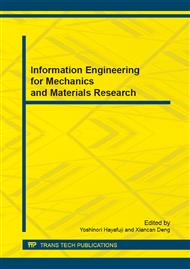[1]
B. Németh, S. Laboncz and I. Kiss, Condition monitoring of power transformers using DGA and fuzzy logic, Electrical Insulation Conference, pp.373-376, May (2009).
DOI: 10.1109/eic.2009.5166373
Google Scholar
[2]
Fu Zhang, Zhang Liang, Comprehensive method detecting the status of the transformer based on the artificial intelligence, 2004 International Conference on Power System Technology, 2004, vol. 2, pp.1638-1643.
DOI: 10.1109/icpst.2004.1460266
Google Scholar
[3]
Hongsheng Hu, Suxiang Qian and Jian Cao, Monitoring and fault diagnosing system design for power transformer based on temperature field model and DGA feature extraction, WCICA, June 2008, pp.1800-1805.
DOI: 10.1109/wcica.2008.4593195
Google Scholar
[4]
W. H. Tang, J. Y. Goulermas, Q. H. Wu and Z. J. Richardson, A probabilistic classifier for transformer dissolved gas analysis with a particle swarm optimizer, IEEE Trans. on Power Delivery, April 2008, vol. 23, no. 2, pp.751-759.
DOI: 10.1109/tpwrd.2008.915812
Google Scholar
[5]
S. Poyhonen, M. Negrea, A. Arkkio, et al, Fault diagnostics of an electrical machine with multiple support vector classifiers, IEEE International Symposium on Intelligence Control, (2002).
DOI: 10.1109/isic.2002.1157792
Google Scholar
[6]
V. N. Vapnik, The nature of statistical learn theory, Springer-Verlag, (1995).
Google Scholar
[7]
Guan Jun, Xu Lizhong, Shi Aiye, Assessment method of water quality of monitoring data based on support vector machine, Application Research of Computers, vol. 23, no. 9, pp.36-38, (2006).
Google Scholar
[8]
Zhousuo Zhang, Lingjun Li, Zhengjia He, Research on diagnosis method of machinery fault based on support vector machine, " Journal of Xi, an Jiao Tong Univerisity, vol. 36, no. 12, pp.1303-1306, (2002).
Google Scholar
[9]
Eberhart R, Kennedy J. A new optimizer using particles swarm theory. In Proc Sixth International Symposium on Micro Machine and Human Science 1995; 39-43.
DOI: 10.1109/mhs.1995.494215
Google Scholar
[10]
Kennedy J, Eberhart RC. Particle swarm optimization. In Proceedings of IEEE International Conference on Neural Networks 1995; 4: 1942-(1948).
Google Scholar
[11]
Eberhart RC, Shi YH. Particle swarm optimization: developments, applications, and resources. Proc IEEE Conf Evol Comput Proc 2001; 1: 81-86.
Google Scholar
[12]
LǕ ZS, Hou ZR. Particle swarm optimization with adaptive mutation. Acta Electronica Sinica 2004; 32 (3): 416-420.
Google Scholar


